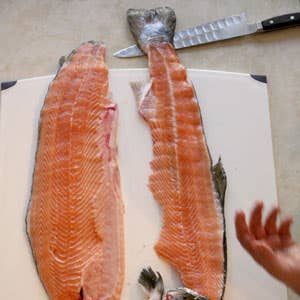
How To Filet A Salmon
It's easy, and worthwhile, to filet your own salmon: not only is doing so far more economical than buying presliced filets, but the practice gives you access to all the tasty, overlooked parts of the fish, such as the belly, head, and collars. (For more about salmon parts, see Take All of Me).
1. Rinse a scaled and gutted salmon under cold water, pat dry with a kitchen towel, and transfer to a large cutting board with the belly facing you. Working with a long, flexible knife, make a diagonal cut behind the gills downward until the backbone stops the blade.
2. Work the knife under the filet. Keep the blade flush against the backbone and parallel to the cutting board. In long, fluid strokes, slice toward the tail to gently release the filet from the body of the salmon. Turn the fish over and repeat with the second filet.
3. Remove the thin ribs, also known as the belly bones, by slicing underneath them toward the tapered end of the filet.
4. Trim off some of the belly 1-2 inches in from the edge to make a more uniform filet, reserving belly for another use.
5. Drape the filet over the top of an inverted bowl so that the pin bones protrude slightly. Run a fingertip lengthwise down the filet to locate the pin bones. Remove the bones with tweezers or fish pliers.
6. To remove the skin, carefully cut through tail end of fish, edging knife between skin and filet. Holding the knife blade firmly in place at a 20-degree angle to the cutting board, grip the tail end of skin with a kitchen towel in your other hand and pull skin taut in a side-to-side motion away from filet, letting the knife do the work.
7. Cleanly slice the filets into 2"-4"-wide portions.
Keep Reading
Continue to Next Story










